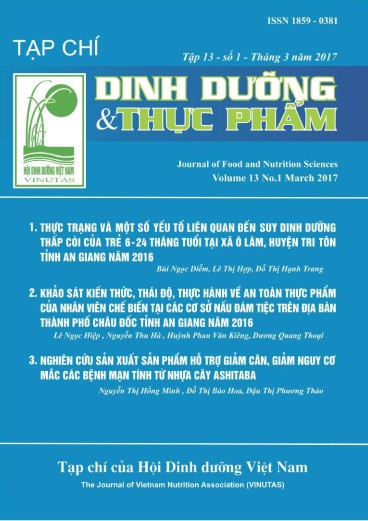RESEARCH ON PROCESSING Of RED-FLESH DRAGON - ALOE VERA JUICE
Main Article Content
Abstract
Red-flesh dragon fruit (Hylocereus polyrhizus) is widely cultivated in the Mekong
Delta including An Giang province due to its high economic value. It grows well on the
mountainous lands such as Tinh Bien and Tri Ton provinces with low pest (insect) rate,
high yield and stable quality of fruit. It contains many high nutritional ingredients, which
are very good for human health such as protein, glucose, organic acids, minerals (Fe, Mg,
Ca), vitamin A, vitamin C, and so on. Moreover, it contains lycopene, known as a natural
antioxidant that can help to fight against cancer, heart diseases and reduce blood pressure.
However, the quantity of red-flesh dragon fruit becomes abundant on harvesting season,
resulting in the backlog and spoilage of fruits, but it becomes rare on the other seasons.
Therefore, this study investigated on effects of processing conditions on quality of redflesh dragon fruit juice. The results showed that the product produced from red-flesh
dragon fruit juice with water at a ratio of 1: 5, pH = 6.0, 10% of aloe vera juice, 4% of
guar gum-xanthan gum, pasteurization at 900C for 15 minutes had high quality in terms
of food hygiene and safety; the absorption A value; viscosity; the content of total acid, vitamin C, betacyanin content; and sensory properties (color, flavor, appearance, degree of
preference).
Keywords
Red-flesh dragon fruit, dilution, blending, pasteurization
Article Details
References
2. Bùi Hữu Thuận (2000). Hóa học thực phẩm. TP.Cần Thơ: Đại học Cần Thơ.
3. Hà Duyên Tư. (2010). Kỹ thuật phân tích cảm quan thực phẩm. Hà Nội: Đại học Bách Khoa Hà Nội.
4. Lê Thị Thanh Mai. (2006). Phương pháp phân tích thực phẩm. Hà Nội: Đại học Bách Khoa Hà Nội
5. Lê Ngọc Tú, La Văn Chứ, Đặng Thị Thu, Phạm Quốc Thắng, Nguyễn Thị Thịnh, Bùi Đức Hợi, Lưu Duẩn và Lê Doãn Biên (2004). Hóa sinh học công nghiệp. Hà Nội: Nhà xuất bản HN.
6. Lý Nguyễn Bình (2013). Các quá trình nhiệt độ cao trong chế biến thực phẩm. TP.Cần Thơ: Đại học Cần Thơ.
7. Nguyễn Trọng Cẩn và Nguyễn Lệ Hà (2010). Nguyên lý sản xuất đồ hộp thực phẩm. TP.HCM: Nhà xuất bản Khoa học Kỹ thuật.
8. Phạm Minh Nhựt, Đàm Thị Hà (2013). Bước đầu nghiên cứu quy trình sản xuất nước thanh long lên men bằng nấm men Saccharomyces cerevisiae. Tạp chí khoa học và Công nghệ Đại học Đà Nẳng số 1(62) 2013.
9. Trần Linh Thước (2005). Phương pháp phân tích vi sinh vật trong nước, thực phẩm và mỹ phẩm. TP.Hồ Chí Minh: Nhà xuất bản Giáo dục.
10. Võ Tấn Thành (2000). Phụ gia trong sản xuất thực phẩm. TP.Cần Thơ: Đại học Cần Thơ


